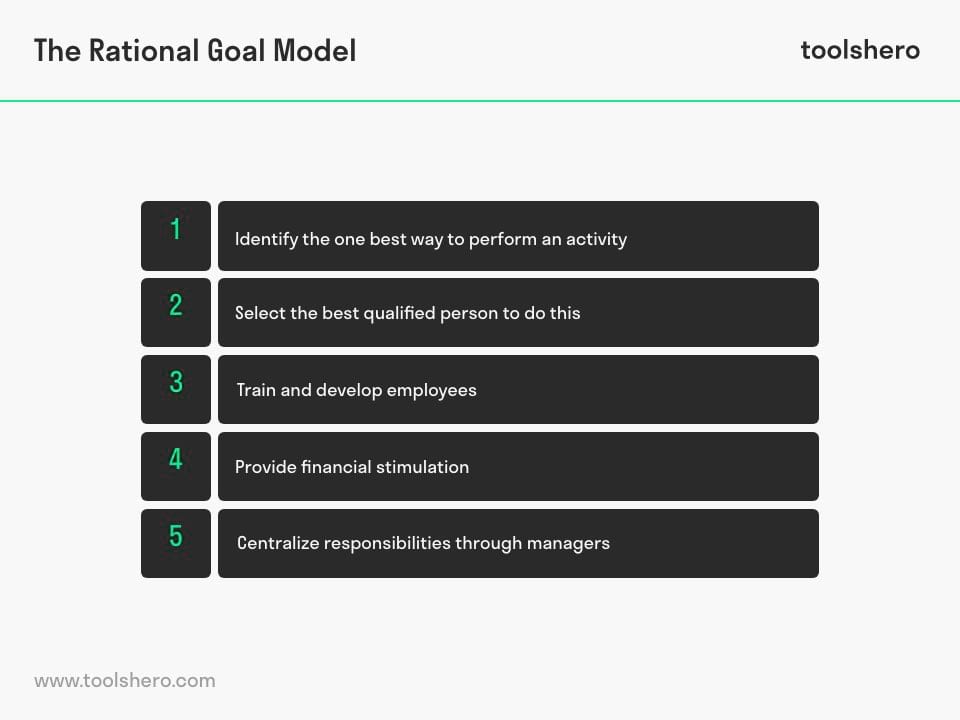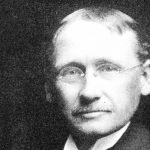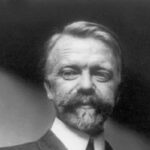Rational Goal Model of Management

Rational Goal Model of Management: this article provides a practical explanation of the Rational Goal Model. Next to what it is (definition and background), this articel also higlights the origin, The 5 principles of the Rational Goal Model, Advantages and Disadvantages, and tips to use this theory in practice. After reading, you will have a basic understanding of this powerful management theory. Enjoy reading!
What is the Rational Goal Model of Management?
The Rational Goal Model is a management model by Frederick Taylor and is also known as scientific management.
Management is the process of managing and achieving both individual and collective goals through the deployment and allocation of resources and decision making. A few things are important here: performance, efficiency, innovation and value creation. Good managers are able to balance these matters.
To a certain extent, these four values apply to all levels of management. Each of these four values is highlighted in the different management models.
Management models
These models are focused on: internal processes (Henri Fayol), human relations (Elton Mayo), open systems and thus rational goals. Each of these models addresses issues relevant to the management of an organisation supported by science and technology.
Definition of the Rational Goal Model
Frederick Taylor’s Rational Goal Model tries to get managers to use science in the production of their goods.
This would mean maximum profit for the organisation and therefore also for the employee. In this way, employees could achieve their maximum productivity and potential. Taylor’s Rational Goal Model is based on five principles. These are described in the article.
Origin Rational Goal Model
Frederick Taylor introduced the Rational Goal Model at the beginning of the twentieth century. The model particularly emphasises the importance of external management control within the organisation.
According to Taylor, this is necessary to fulfil the responsibilities of managers and producers to deploy people and other resources in order to achieve optimal productivity.
In order to perform effectively, a number of things are important: setting goals, accelerating productivity, and becoming more profitable than the competition by using technology, financial incentives and efficiency studies. These points reflect the five principles of the Rational Goal Model.
The 5 principles of the Rational Goal Model
- Identify the only and best way to perform an activity
- Select the highest qualified person to do this
- Train and allow employees to grow
- Provide financial stimulation
- Centralise the responsibilities with managers

Figure 1 – Rational Goal Model of management: 5 principles
Frederick Taylor’s theory was later built upon by Henry Gantt and Frank & Lillian Gilbreth. They used new engineering techniques in time, motion and internal process model studies to increase the capability of technological production solutions. These time, movement and internal process model studies provided detailed and valuable information about production activities such as transporting, assembling and gripping. The time it took to complete a task was central in this process.
Advantages of the Rational Goal Model
The strength of this model is that it emphasises that structure and action by managers is crucial. The results of the aforementioned time and movement studies imposed robotic movements on humans in the early twentieth century that were impossible to sustain.
The Rational Goal model takes this, and the individual psychosocial needs of employees, into account, like the Human Relations Theory of Management. Frederick Taylor also knew that exhausted or neglected employees often result in shattered organisational cohesion.
Disadvantages of the Rational Goal Model
Even though the use of this model could actually lead to more efficient employees, it also has flaws. Taylor’s scientific management theory focuses on efficiency, as does Max Weber’s management theory.
However, Taylor believed that employees should be rewarded when productivity rose. The main purpose of management, according to Taylor, is to ensure maximum welfare for the employer that is linked to the maximum welfare of the employee.
Many of the tasks discussed in this theory are generic and subordinate. Many employees therefore feel that they are part of an assembly line rather than being able to contribute creatively to the team.
Example Rational Goal Model of Henry Ford
As discussed in this article, there are several management theories that have been developed in quick succession. They are not intended to select and apply just one of these, but rather all at the same time.
At the time of the introduction of the Rational Goal Model, Henry Ford began production of the first Ford. During the production process, he incorporated various ideas from Frederick Taylor’s scientific management theory.
The four principles that Henry Ford used during the production process of the first Ford were:
- Develop a vision and manual for each function within the process
- Select the employees based on the work they will be doing and train them effectively
- Have the employees work according to the principles of the known science behind the job
- Support employees by developing careful planning and by paving the way for them
Tips Rational Goal Model
Applying this model in practice is not difficult. The model was developed at a time when most businesses were fairly straightforward compared to 21st century businesses. The following tips form a summary of the action points that can be derived from this theory.
Divide assignments into smaller tasks
In order to keep the production process clear, it is important that a large project is not attributed to one person. Managers therefore split larger tasks into smaller parts.
These smaller parts are intended to create clarity and to work more efficiently. Multiple employees work on an assignment like this, and each employee takes care of their own part.
Delegate tasks and responsibilities and allow your staff to grow
Managers and other supervisors measure the most efficient way to perform a particular task, and delegate that task and the appropriate work method directly to those employees who have the right skills and competencies. These employees are then further trained by management.
The roles of employees during the time when this model was developed were often simple and repetitive. Employees often feel unimportant when they are doing the same work over and over again. However, for Frederick Taylor, the employee plays a huge role in a company’s success.
Track the performance
Managers and supervisor ensure that employees work as is expected of them. Efficiency is leading in the Rational Goal Model. The same managers must ensure that employees are retrained when more effective practices are discovered.
Frederick Taylor emphasised the importance of financial compensation for the increasing efficiency and productivity of employees. This would motivate them to perform high quality work. Frederick Herzberg partly refutes this line of thought in his 2-factor theory.
Assign tasks to managers and employees
Many companies have multiple employees at each level of the organisation, from managers to employees and from supervisors to part-timers. The more experience and drive there is within the organisation, the more likely it is that someone will get a managerial position. This often applies to the entire business community.
Frederick Taylor believed in a similar hierarchy. This hierarchy had three layers. Each level is given exact responsibilities and instructions designed for their specific role. According to Frederick Taylor, it is also important that they all respect the hierarchy.
Now it is your turn
What do you think? Are you familiar with the explanation of the Rational Goal Model? Do you see similarities with other management models? Do you think this theory is outdated? Or do you think this theory is still very relevant and is sometimes forgotten by managers? Do you have any other tips or additional comments?
Share your experience and knowledge in the comments box below.
More information
- Nadworny, M. J. (1957). Frederick Taylor and Frank Gilbreth: competition in scientific management. The Business History Review, 23-34.
- Steglich, C. E. G. (2003). The framing of decision situations: automatic goal selection and rational goal pursuit. University of Groningen.
- Taylor, F. W. (1914). Scientific management: reply from Mr. FW Taylor. The Sociological Review, 7(3), 266-269.
- Taylor, F. W. (2004). Scientific management. Routledge.
How to cite this article:
Janse, B. (2021). Rational Goal Model of Management. Retrieved [insert date] from Toolshero: https://www.toolshero.com/management/rational-goal-model/
Original publication date: 03/11/2021 | Last update: 07/20/2023
Add a link to this page on your website:
<a href=”https://www.toolshero.com/management/rational-goal-model/”>Toolshero: Rational Goal Model of Management</a>












